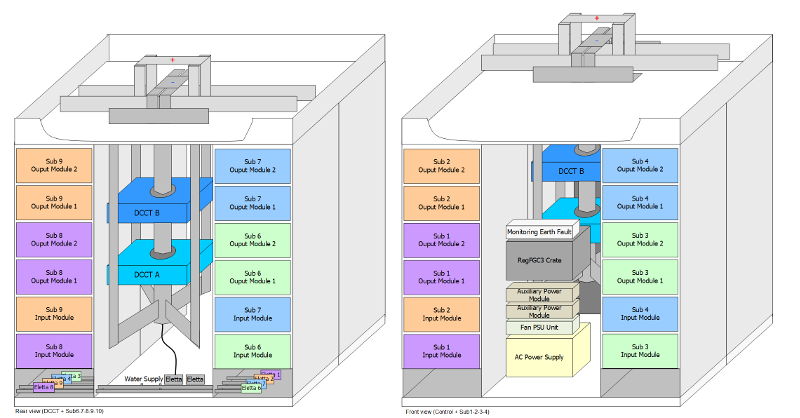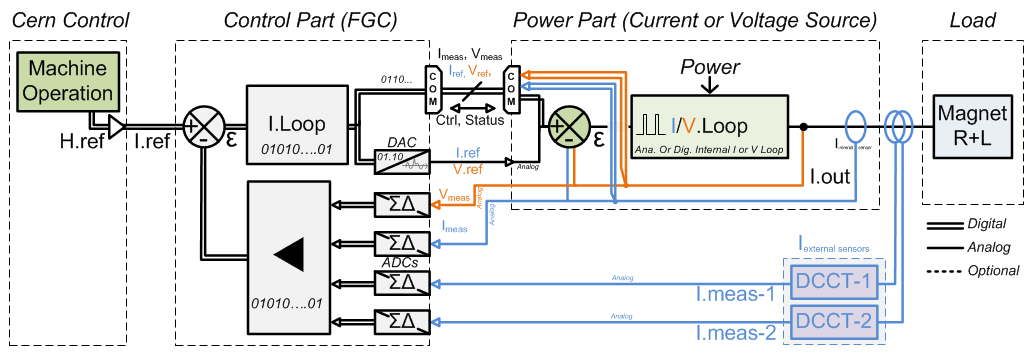|
HCRPAFF / HL-LHC14kA-08V |

|
 |
|
 |
|
 |
CERN
|
SY
|
SY-EPC
|
EDMS
|
PROJECTS
|
ODF
/
OOXML
|
|
CERN
|
SY
|
SY-EPC
|
EDMS
|
PROJECTS
|
ODF
/
OOXML
|

|
|
|
|||||||||||||||||||||||||||||||||||||||||||||||||||||||||||||||||||||||
| Power In | 3 ~ 230 V/ 131 A op. |
| Power Out | [+14 kA; +08 V] |
| Converter Type | 1 Quadrant |
| Control type | FGC3.2 + RegFGC3 / Ethernet |
| Current Accuracy | 0.2 ppm@ 30 mn |
| 0.5 ppm@ 24 h | |
| 10 ppm@ 1 year | |
| (1 ppm=14 mA) |
 Involved Peoples
Involved Peoples
 Yves THUREL
Yves THUREL
|
|
 Edwin ROHRICH
Edwin ROHRICH
|
|
 Nicolas Kuczerowski [2019-2023] Nicolas Kuczerowski [2019-2023] |
 Power Converter Architecture
Power Converter Architecture
This Power Converter is used for powering HL-LHC Superconductive Magnets, and for DC applications.
Different parts were designed and produced separately, with the option of a Power Converter being finally integrated in a housing rack, with 3 main parts:
- Power Part:
- Power Rack (AC & DC distribution, interconnections)
- Ideally Removable Power Modules, including redundancy as much as possible.
- CERN Digital Controller (FGCx?):
- The high level control from and to the Cern Control Room (using fieldbus to be defined)
- The high precision digital current loop (when a voltage source is controlled)
- Collecting and reporting all status, faults, and measurements from all the different parts to the remote services, for diagnostic and operation purposes.
- High Precision Current sensor(s) (DCCTs)
- Measuring DC current at the required precision.
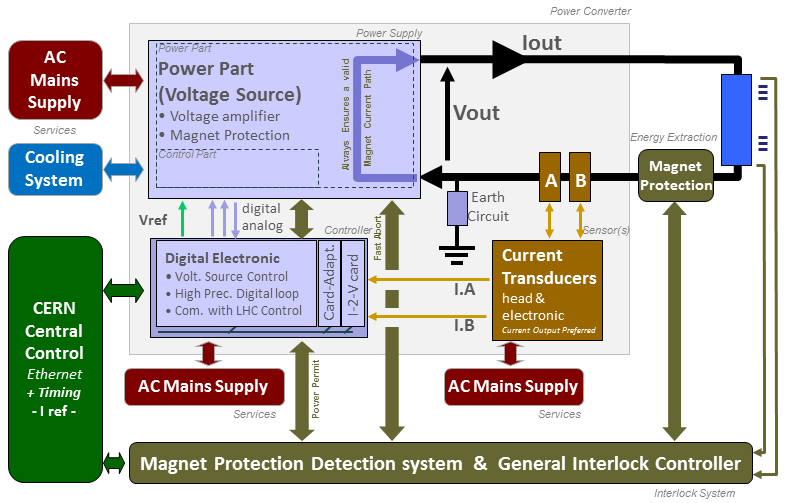
Power Converter simplified Architecture .ppt
 Power Part
Power Part
A high current switch mode power converter, designed for powering of superconducting loads requiring positive current only, operating in 1 quadrants. Constructed from a modular architecture composed of 07..08 x [+2 kA; +08 V] power modules (active redundancy in a n+1 configuration).
Primary use is in HL-LHC particle accelerator. The converter is water cooled, and is thus ideally suited to situations where air losses must be carefully managed. Designed for underground operation, extensive remote diagnostics have been foreseen to allow efficient monitoring and fault diagnostics without requiring being present locally.
Additionnal free wheeling diodes located in the Power Rack always provide a current path, independent of the converter status.
| Power In | 3 ~ 400 V/ 131 A op. |
| Power Out | [+14 kA; +08 V] (Brick: + 2kA + 08V) |
| Cooling type | Water Cooling + Air forced on each power module |
| In/Out rack connection: DN25. | |
| Nominal Water Condition [+14 kA; +08 V] → 25 l/min @ 3 bars of Differential Pressure Drop. | |
| Converter Weight | Full Equipped Rack 14 kA ......... xxxx kg (Pwr Modules & full elec. chassis + DCCTs incl.) |
| Input Power Module ................... TBD (22) kg | |
| Output Power Module ................ TBD (37) kg | |
| Converter Control Electronic .... TBD (12) kg | |
| Aux Power Module ....................... TBD (5) kg | |
| Electronic Chassis ........................ TBD (5) kg (Chassis + FGC + 1x PSU + 1 AC-DC) | |
| DCCT Electronic Chassis ............. TBD (5) kg | |
| DCCT Head ................................ 60 kg |
Power Converter is normally assembled using a n+1 Power Bricks [+2 kA; +08 V] to provide active redundancy in case of one subconverter is lost. A [+14 kA; +08 V] is composed of 8x [+2 kA; +08 V] Power Bricks, working as current source being controlled by a Voltage Source main control.

[2 kA; 08 V] Sub-Converter simplified Architecture / Topology .vsd
Power Brick is actually a high frequency current source (7-8 kHz) controlled by a 1 kHz bandwidth voltage loop, even if voltage source capacitors are located in the current source block for mechanical reasons. Representation below gives a symbolic structure of the power converter, clarifying the cascade loops. ( Is1 & Is2 are actually assumed to be representative and equal to the current of each power transformer secondaries). The multiplication of rectifier stages in each output module gives the following advantages: easier design of magnetic parts, lower rating fuse (lower losses) to protect whole Power Converter being short-circuited by a faulty secondary (fuse would immediately blow in case one of the schottky dies, giving the possibility to the whole power converter to reconfigure the current level in other current sources to maintain required voltage level).

[2 kA; +08 V] n+1 redundant Voltage Source simplified Architecture / Topology .vsd
Redundance operation relies mainly on each [2 kA; 08 V] inner current source reactivity, so that load output current is not impacted by the loss of one sub. Of course a sudden short at the level of the output stage of a sub converter will likely lead to a converter global fault stop, despite the presence of output fuse.
![]() No fault
-
No fault
-
![]() Sub Fault Transition
-
Sub Fault Transition
-
![]() Sub Fault state
Sub Fault state
Power converter redundance .vsd
 Control Part
Control Part
Control & regulation principles are summarized in a detailled schematics representating only the part involved in the output current regulation scheme.
Control & regulation principles are summarized in a detailled schematic representating only the part involved in the output current regulation scheme.
Regulation Control simplified schematic .vsd
High precision current control loop is managed by the digital controller called FGC (Function Generator Controller). This unit includes a high precision Sigma Delta Analog to Digital Converter which digitalize the analog current measurement coming from 1 or 2 Current sensors (DCCTs: DC current Transducer). Precision is then directly relying on sensor precision: current sensors, the ADCs, and the algorithm being used for the regulation loop. Voltage source is then used as a power amplifier, powering the load through a high bandwidth voltage loop.
 Magnet Protection
Magnet Protection
Power Converter is part of magnet protection scheme, even if not directly fully responsible of the monitoring and diagnostic of the superconductive magnet status. Dedicated systems QPS (Quench Protection System) + PIC (Power Interlock Controller) can interlock Power Converter if magnet safety requires it.
Power Converter is then expected to:
- Always ensure that external protection system can stop the Power Converter through a safe signal called Fast Abort. This redundant signal uses 2 paths to interlock and stop the converter and its redundancy is checked each time it acts. It directly acts on DC Contactor bobbin, ensuring its opening as required.
- Stop powering the load in safe way (handling the magnet energy even when stopping, through dedicated system called free-wheeling diode). This passive system based on different paths using several free-wheeling diodes in the rack provide a safe discharge path for magnet current (energy).
- Monitor Earth current of the total circuit: converter + load (magnet and its DC cables), and take the right action if threshold reached.
- Fast Abort Interface
Machine Interlock system can request a Fast Abort to the converter, in case a quench is detected. Converter is then assumed to react as soon and as quick as possible, stopping providing energy to the load. This signal being part of the magnet safety scheme, it is acting redundantely at the level of Converter DC Mains Contactor. 2 paths are used and monitored to stop the contactor. The schematic is described below:
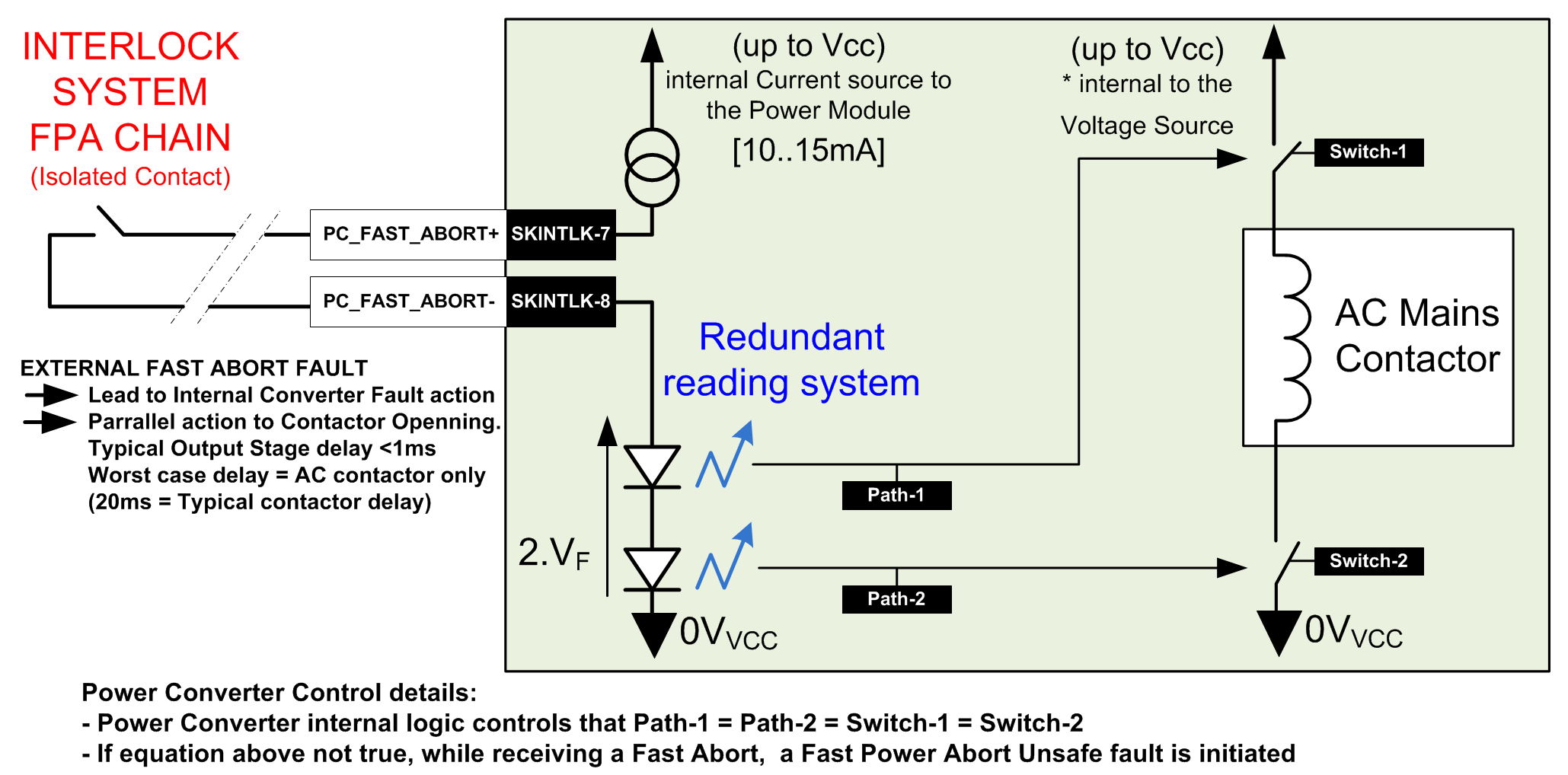
Fast Abort Interface .vsd
- Free-wheeling diode
The system is based on 3 different paths provided by Free-Wheeling Diodes providing a safe path for magnet current.
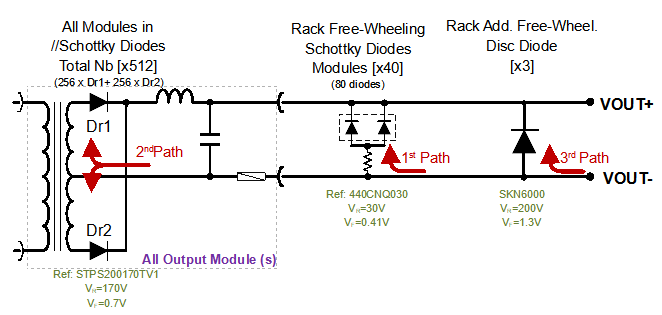
free-wheeling Diode System simplified schematic .vsd
- Earth System
The circuit injects a 100 mA DC current on a grounded resistive branch, resulting in a common mode voltage at the output circuit easing the earthing fault detection. Output circuit Common mode voltage is, without any earth fault, around 10V (=100 mA x 100 Ohms), and is not relying on load operation, making possible to detect an earth fault even with converter being OFF. (OFF, not condamned).
If an earth fault occurs on the output circuit, a faulty current will be deviated from the initial path back to earth by using the shunt 10 Ohms resistor path (monitored for detecting this fault).
Overcurrent protection is achieved through a 1A-100V fast fuse in series in the path provided for the earthing fault current.

Earthing System simplified schematic .vsd
- CDB System
The converter uses the Circuit Disconnector Box system, located on DC output.

CDB System simplified schematic .odg
 Power Converter Components .vsd
Power Converter Components .vsd
A power converter is actually a sum of different equipments under several different sections in the SY-EPC group. The modularity is a key factor for easier maintenance with regards to LHC tunnel access conditions.
Power Converter is built through two Power Racks. One contains the six Sub-Converter Power Modules, when the second one includes the converter crowbar and DC-contactor systems, the converter power part control electronic, the FGC complete Electronic Chassis, the two DCCTs head and their electronics.
 Magnet Types
Magnet Types
| D1 & D2 magnets | Separation and recombination dipoles |
| D1: MBXF, D2: MBRD |
 Machine Installation
Machine Installation
| HL-LHC Use | 08 Power Converters |
| 08 = 2 x (2 in point.1, 2 in point.5) |
 Production Contract & Contact History
Production Contract & Contact History
| Developped | Designed/CERN | ||
| 2017-2023 | |||
| Manufactured | Contry(s) | ||
| Manufacture | |||
| Production | 1x Proto (IT String) | 1x Proto (P-Hall) | 8x Series(IT String) |
| Responsibles: |  Nicolas KUCZEROWSKI
Nicolas KUCZEROWSKI
|
 Converter Circuit Names
Converter Circuit Names
RPxxx
| TOP | CHARTE | HTML | CSS | Ver : 23-04-2024 17:57:51 | Webmaster : Michel GEORGES. |
